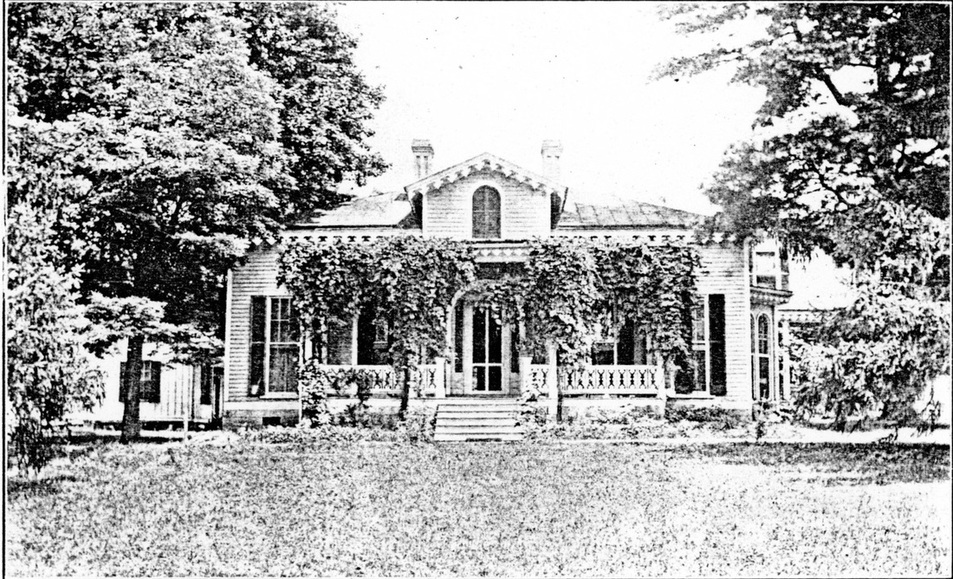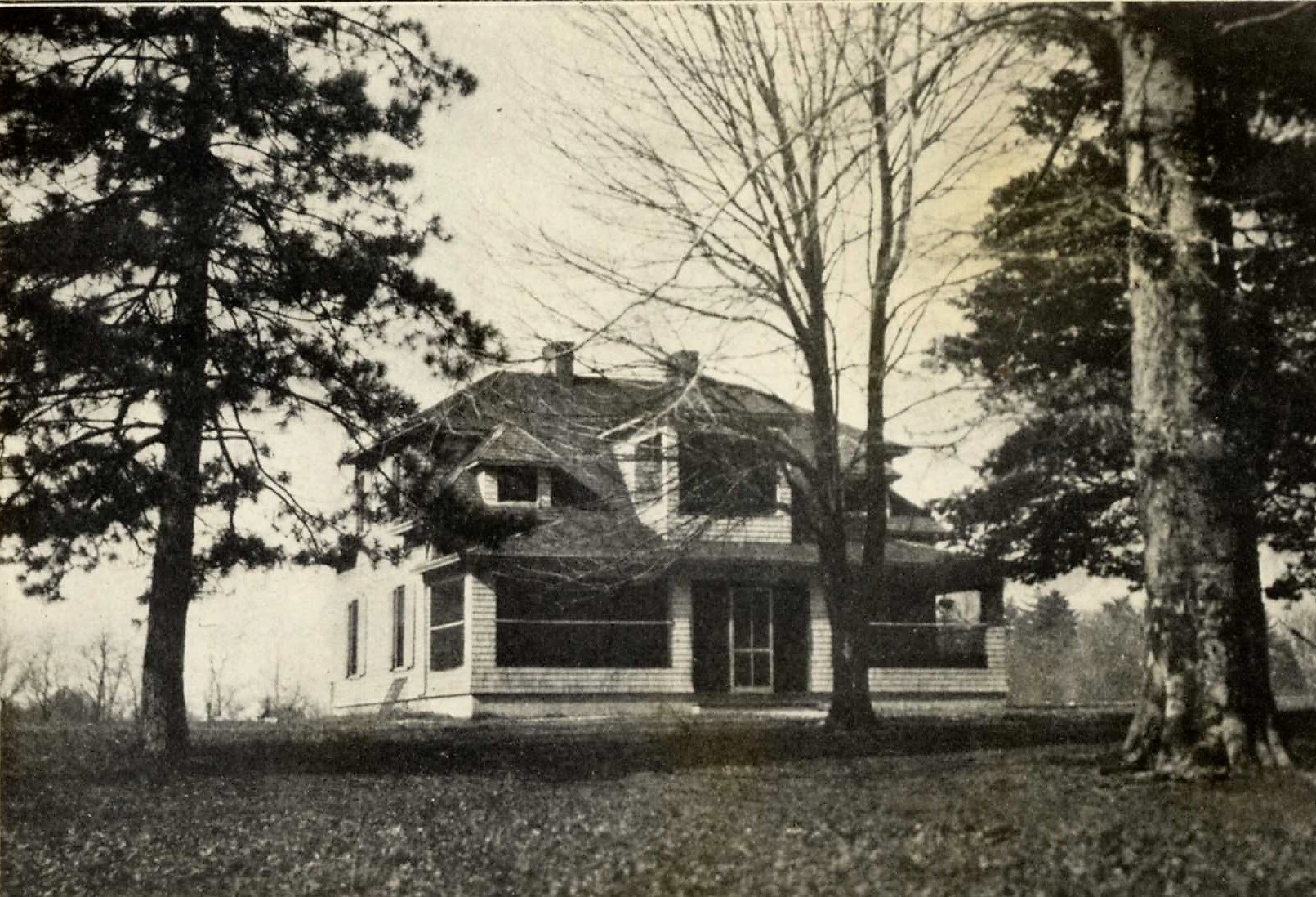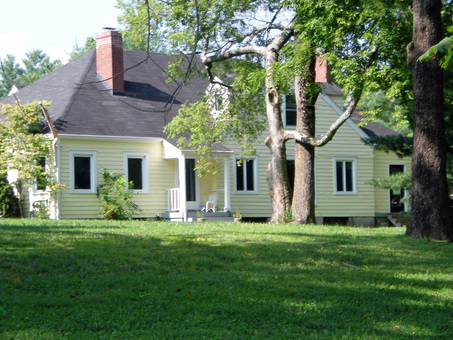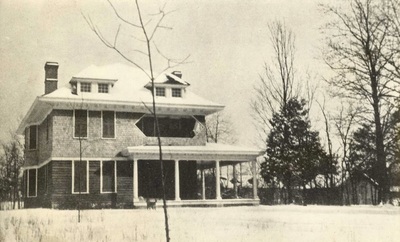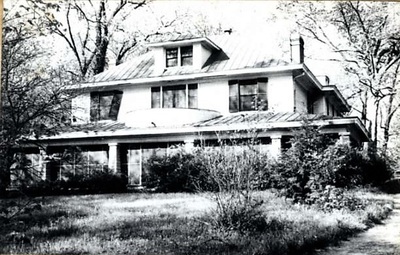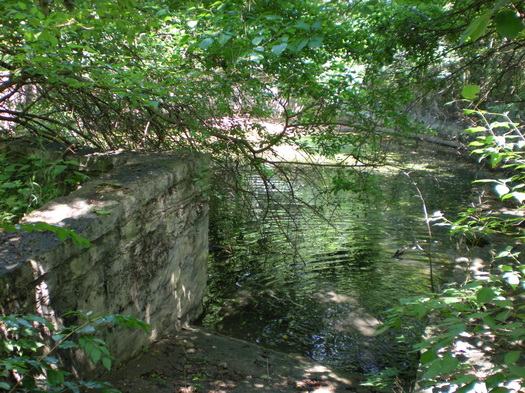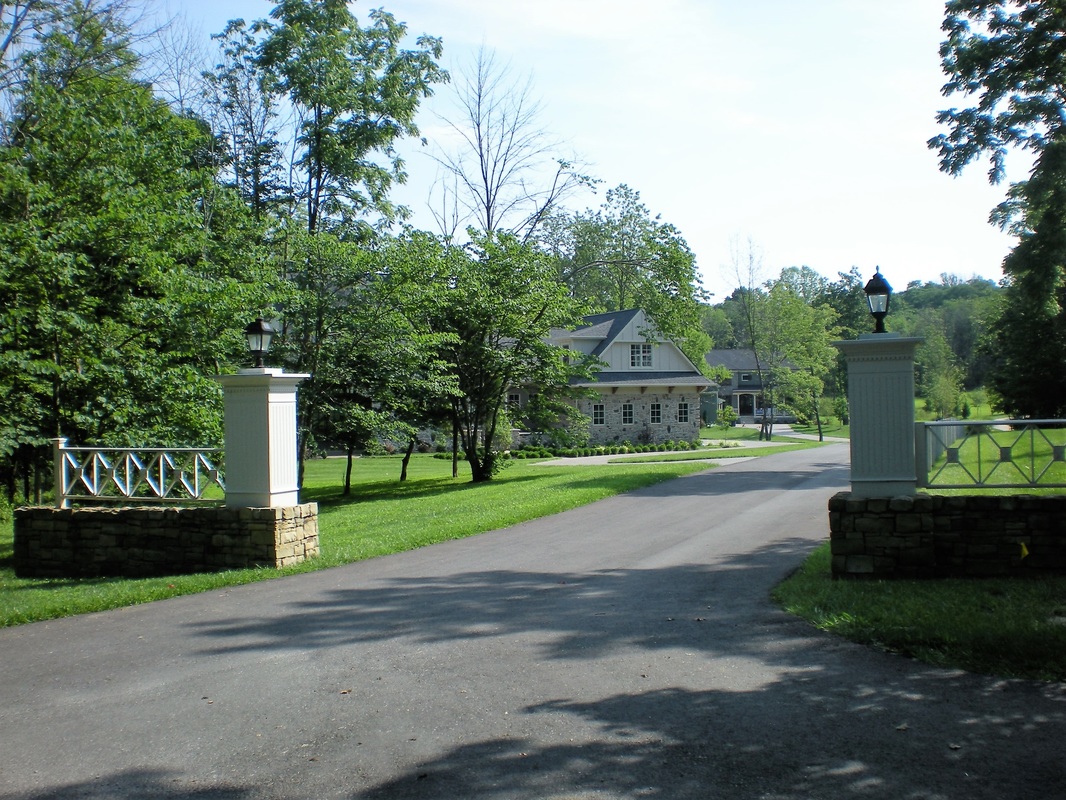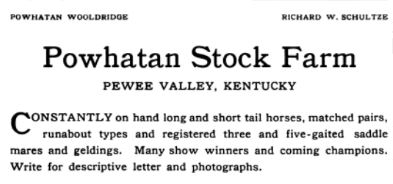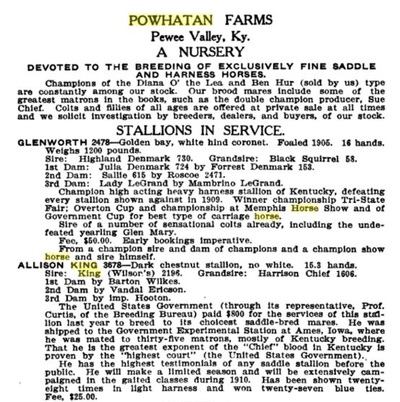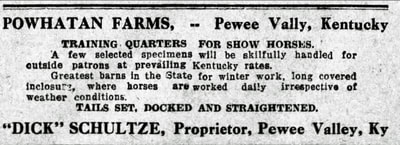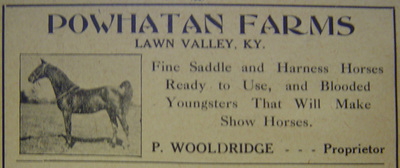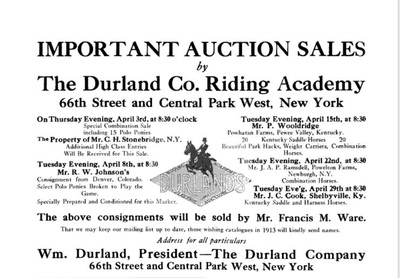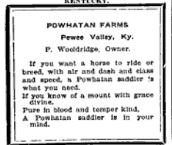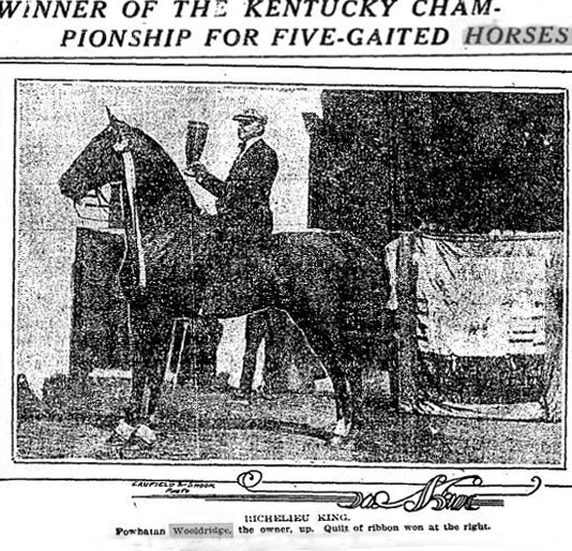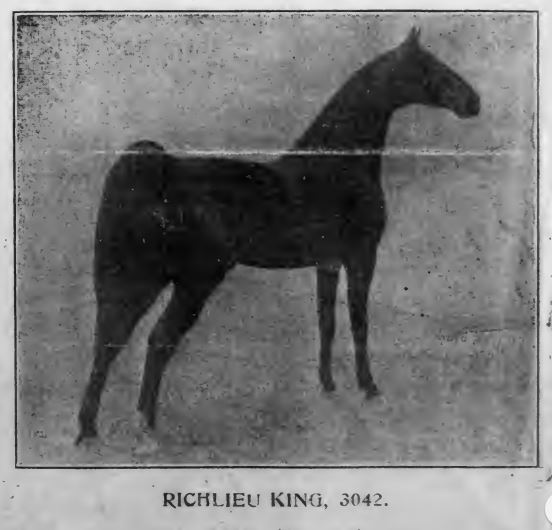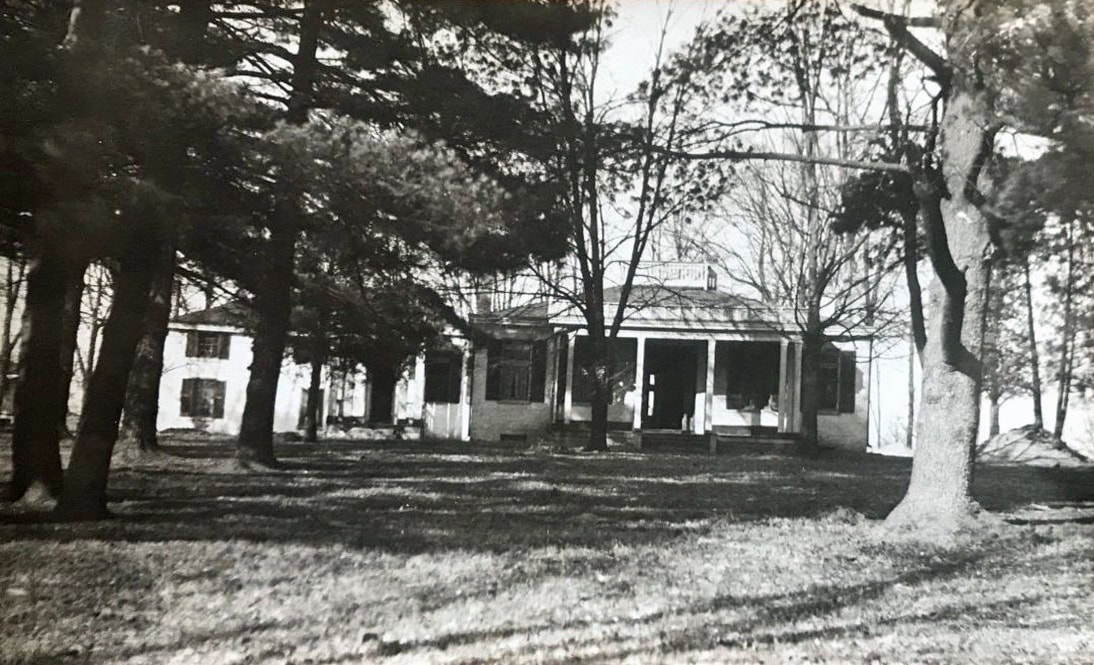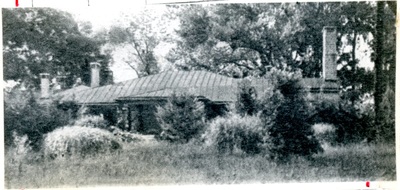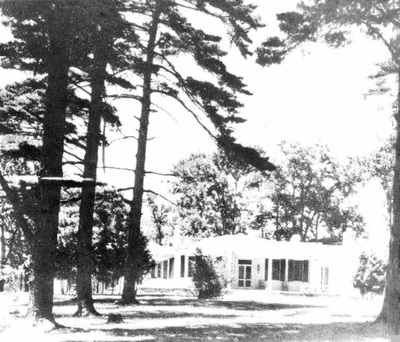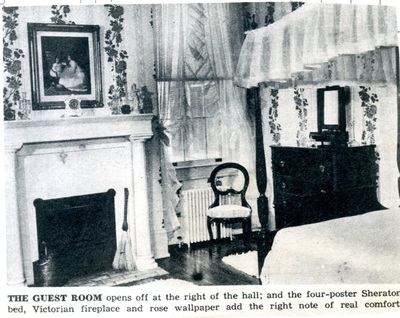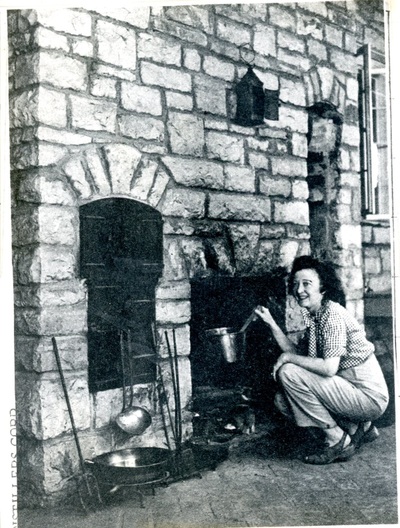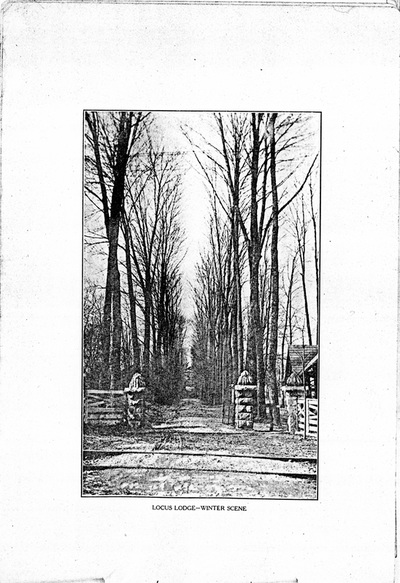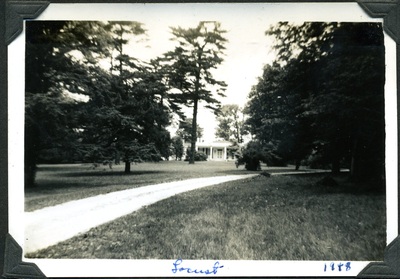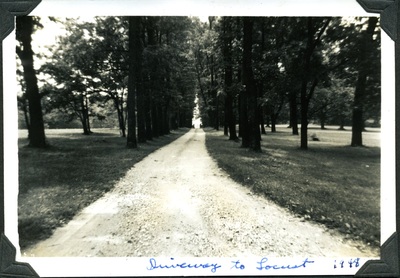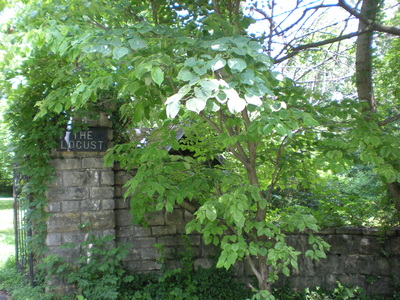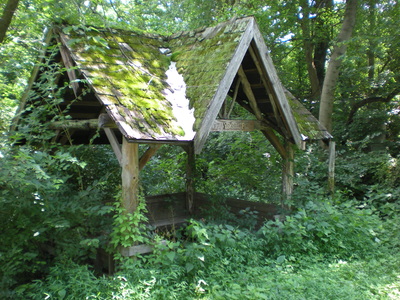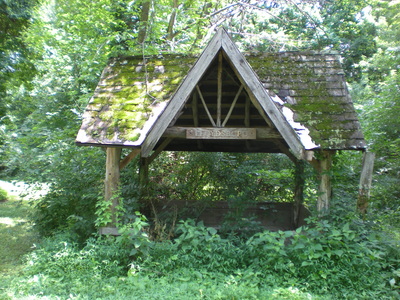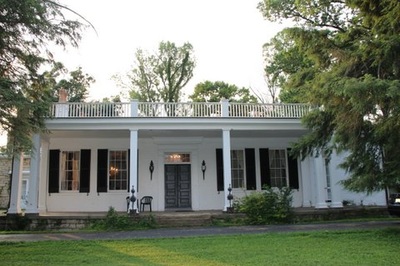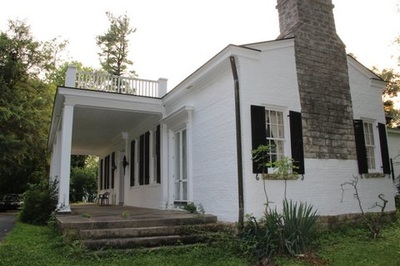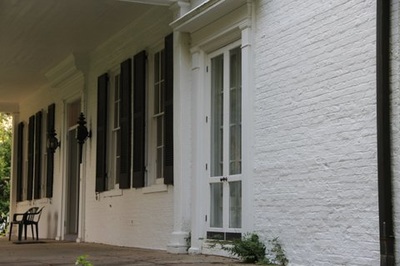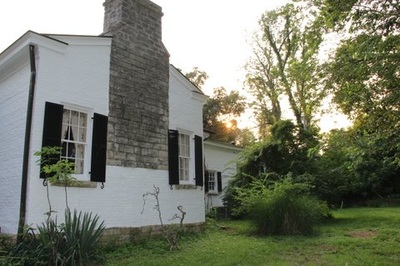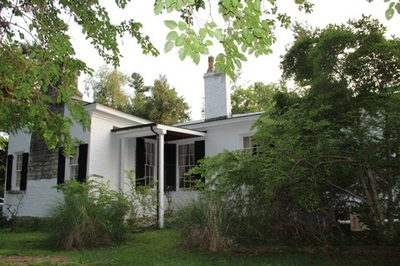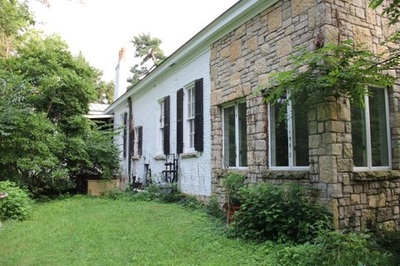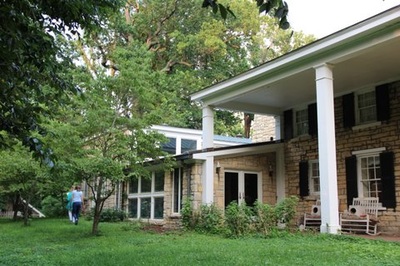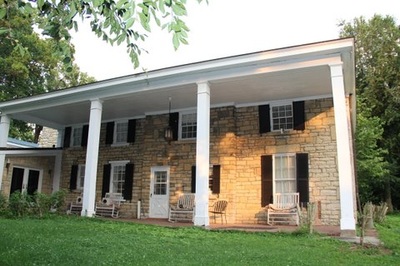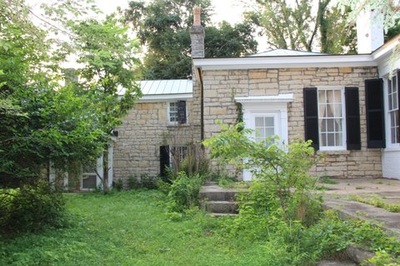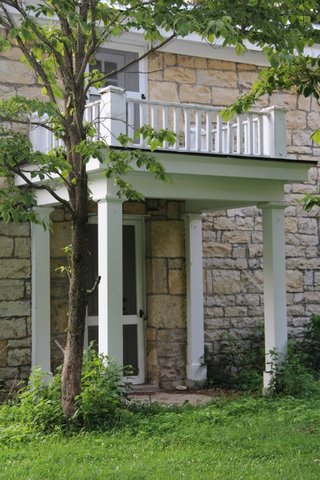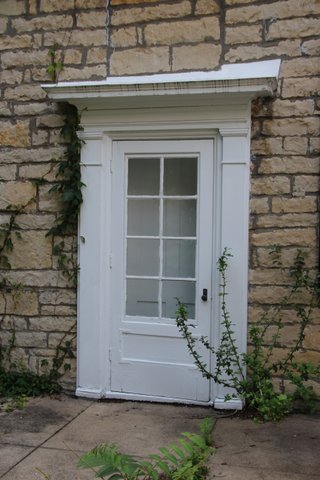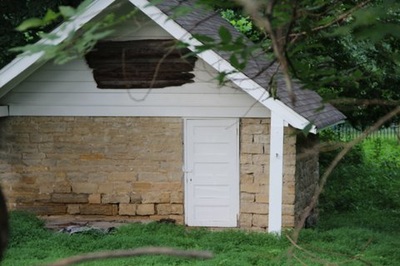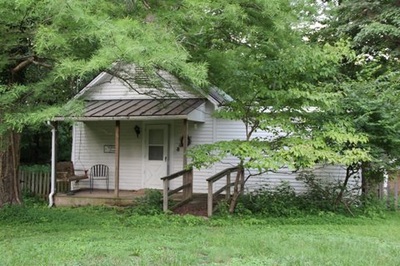The Locust: The Wooldridge Years and Beyond
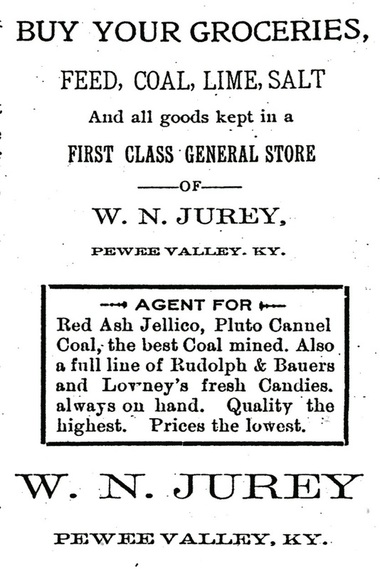 Advertisement for W.N. Jurey's store (now the Little Colonel Playhouse) promoting Jellico Coal. From the "Confederate Home Messenger" published by the Kentucky Confederate Home.
Advertisement for W.N. Jurey's store (now the Little Colonel Playhouse) promoting Jellico Coal. From the "Confederate Home Messenger" published by the Kentucky Confederate Home.
It didn't take long for Powhatan Wooldridge to decide what to do with Locust Lodge. Within a few years, he'd turned the estate into a stock farm specializing in "the peacock of the show ring," Saddlebred horses.
A uniquely American breed, Saddlebreds were relatively new to bloodlines and pedigrees, though they'd been around since the 19th century. During the Civil War, they were called "Kentucky Saddlers" and were the choice of high-ranking officers on both sides of the fray. Union General Ulysses S. Grant rode Cincinnati, while Confederate General Robert E. Lee rode Traveller.
However, it wasn't until 1891 -- more than a quarter of a century after the war ended -- that a breed registry was established and the National Saddle Horse Breeders Association (now the American Saddlebred Horse Association) was born. The man behind its formation was Gen. John Breckenridge Castleman, of Louisville. While serving in the Confederate cavalry during the war, he became an ardent admirer of the saddler's fast, easy gate; endurance; intelligence; and beauty.
Gen. Castleman became the National Saddle Horse Breeders Association's first president and served in that capacity for many years. In 1913, five years before his death, a bronze statue of the general on his favorite Saddlebred, Caroline, was dedicated in Cherokee Triangle. Purportedly, it's the only equestrian statue in the world where both horse and rider posed for the artist.
Powhatan Johnson Wooldridge came from an old and moneyed Kentucky family. He had the deep pockets breeding horses requires. His father, also Powhatan Wooldridge, was the son of Col. Samuel L. Wooldridge, of Versailles. Col. Wooldridge's obituary, picked up by the January 9, 1902 Courier-Journal, noted that coal was the source of the family fortune:
... Col. Wooldridge ... was a native of Woodford County and the son of Powhatan Wooldridge, Esq. His grandfather, Edmund Wooldridge, was one of the earliest settlers of this county, and came here from Powhatan county, Va. His grandmother was a daughter of John Watkins, the founder of Versailles, and Mary Hudson, the sister of Henry Clay's mother. Col. Wooldridge was engaged in the cotton business in New Orleans before the war and afterword engaged in farming near Versailles .... For seventeen years he had been president of the Woodford Bank of Versailles, and was long president of the famous Wooldridge-Jellico Coal Mines at Jellico, Tenn., which were developed by him ..He leaves an estate valued at $250,000-$300,000 ...
On his mother's side, Powhatan Johnson Wooldridge's great-grandfather was Robert Tyler (September 14, 1805-April 27, 1852), a Louisville attorney who served as Jefferson County Clerk in 1824; practiced law with James Guthrie; and had large landholdings both in Louisville and St. Louis. Powhatan's grandmother, Mary Lawrence Johnson, inherited a sizable estate. Despite the 1898 bankruptcy of her husband, Charles F. Johnson, a VP with the Columbia Finance & Trust Company, his grandmother was able to hold onto her money and real estate and pass it along to her children. Evidently, it was more than sufficient to construct a major public building. On November 26, 1899, the Courier-Journal announced his mother's plans to build a new office building in downtown Louisville by the courthouse:
SIX STORIES
__________
NEW OFFICE BUILDING FOR LOU-
ISVILLE
__________
To Be Built by Mrs. Powhatan Wool-
dridge and Cost $50,000 -- Work
Begins in March
A handsome office building, six stories high, will be built at Fifth street and Court Place by Mrs. Powhatan Wooldridge at a cost of $50,000. The building will be modern in every detail and will be situated at the west end of and immediately adjoining the Evans block, which will be remodeled and made part of the new building ... Mr. Kenneth McDonald, the architect, says the building will be completed by next September.
The building will have a frontage of thirty feet on Court Street and will extend sixty-two feet in the rear. The site on which it stands was purchased by Mrs. Wooldridge from Mr. Embry Swearingen, who is President of the Kentucky Title Company. Mrs. Wooldridge already owns the Evans block.
The entire first floor and basement of the new building will be occupied by the fire-proof vaults of the Kentucky Title Company. The building will be known as the Kentucky Title Company Building...
A uniquely American breed, Saddlebreds were relatively new to bloodlines and pedigrees, though they'd been around since the 19th century. During the Civil War, they were called "Kentucky Saddlers" and were the choice of high-ranking officers on both sides of the fray. Union General Ulysses S. Grant rode Cincinnati, while Confederate General Robert E. Lee rode Traveller.
However, it wasn't until 1891 -- more than a quarter of a century after the war ended -- that a breed registry was established and the National Saddle Horse Breeders Association (now the American Saddlebred Horse Association) was born. The man behind its formation was Gen. John Breckenridge Castleman, of Louisville. While serving in the Confederate cavalry during the war, he became an ardent admirer of the saddler's fast, easy gate; endurance; intelligence; and beauty.
Gen. Castleman became the National Saddle Horse Breeders Association's first president and served in that capacity for many years. In 1913, five years before his death, a bronze statue of the general on his favorite Saddlebred, Caroline, was dedicated in Cherokee Triangle. Purportedly, it's the only equestrian statue in the world where both horse and rider posed for the artist.
Powhatan Johnson Wooldridge came from an old and moneyed Kentucky family. He had the deep pockets breeding horses requires. His father, also Powhatan Wooldridge, was the son of Col. Samuel L. Wooldridge, of Versailles. Col. Wooldridge's obituary, picked up by the January 9, 1902 Courier-Journal, noted that coal was the source of the family fortune:
... Col. Wooldridge ... was a native of Woodford County and the son of Powhatan Wooldridge, Esq. His grandfather, Edmund Wooldridge, was one of the earliest settlers of this county, and came here from Powhatan county, Va. His grandmother was a daughter of John Watkins, the founder of Versailles, and Mary Hudson, the sister of Henry Clay's mother. Col. Wooldridge was engaged in the cotton business in New Orleans before the war and afterword engaged in farming near Versailles .... For seventeen years he had been president of the Woodford Bank of Versailles, and was long president of the famous Wooldridge-Jellico Coal Mines at Jellico, Tenn., which were developed by him ..He leaves an estate valued at $250,000-$300,000 ...
On his mother's side, Powhatan Johnson Wooldridge's great-grandfather was Robert Tyler (September 14, 1805-April 27, 1852), a Louisville attorney who served as Jefferson County Clerk in 1824; practiced law with James Guthrie; and had large landholdings both in Louisville and St. Louis. Powhatan's grandmother, Mary Lawrence Johnson, inherited a sizable estate. Despite the 1898 bankruptcy of her husband, Charles F. Johnson, a VP with the Columbia Finance & Trust Company, his grandmother was able to hold onto her money and real estate and pass it along to her children. Evidently, it was more than sufficient to construct a major public building. On November 26, 1899, the Courier-Journal announced his mother's plans to build a new office building in downtown Louisville by the courthouse:
SIX STORIES
__________
NEW OFFICE BUILDING FOR LOU-
ISVILLE
__________
To Be Built by Mrs. Powhatan Wool-
dridge and Cost $50,000 -- Work
Begins in March
A handsome office building, six stories high, will be built at Fifth street and Court Place by Mrs. Powhatan Wooldridge at a cost of $50,000. The building will be modern in every detail and will be situated at the west end of and immediately adjoining the Evans block, which will be remodeled and made part of the new building ... Mr. Kenneth McDonald, the architect, says the building will be completed by next September.
The building will have a frontage of thirty feet on Court Street and will extend sixty-two feet in the rear. The site on which it stands was purchased by Mrs. Wooldridge from Mr. Embry Swearingen, who is President of the Kentucky Title Company. Mrs. Wooldridge already owns the Evans block.
The entire first floor and basement of the new building will be occupied by the fire-proof vaults of the Kentucky Title Company. The building will be known as the Kentucky Title Company Building...
When Powhaton Johnson Wooldridge purchased Locust Lodge, he was a newlywed. He'd married Margaret Bainbridge Cox on October 28, 1902 at Calvary Episcopal Church in Louisville. She was the daughter of Luke Obousier Cox, a businessman from Owenton who moved to Louisville in 1890 and eventually became President of the Union National Bank.
He may have learned the property was on the market through his wife's friendship with the Hite family. One of Margaret's bridesmaid was Nannie Hite Winston, whose aunt and uncle, Nannie Hite and Joseph G. McCulloch, owned property in Pewee Valley. McCulloch, in fact, had purchased the old Villa Ridge Inn property in 1891, and for some years used Charles B. Cotton's former mansion as a summer home.
The Wooldridges eventually had five children, three of which lived to adulthood:
He may have learned the property was on the market through his wife's friendship with the Hite family. One of Margaret's bridesmaid was Nannie Hite Winston, whose aunt and uncle, Nannie Hite and Joseph G. McCulloch, owned property in Pewee Valley. McCulloch, in fact, had purchased the old Villa Ridge Inn property in 1891, and for some years used Charles B. Cotton's former mansion as a summer home.
The Wooldridges eventually had five children, three of which lived to adulthood:
- Powhatan Obousier Wooldridge (August 19, 1903-1915)
- Margaret Johnson Wooldridge (September 23, 1904-1998 in Sunnyvale, CA)
- Luke C. F. Wooldridge (1907
- Charles Bainbridge Wooldridge (1910-August 3, 2003 in Scottsdale, AZ)
- James Wooldridge (1915) died at birth
During the first few years after purchasing the property, Wooldridge made many improvements to both Locust Lodge and the estate. According to the National Register nomination:
In 1903 , he expanded the east front room of 1884 to make a library. He installed a large part-brick and part-stone chimney. It is probable that he also added two rooms off the rear of the back east room of the 1884 addition.
At some point, he also added an exercise/therapeutic pool for his horses.
During the first few years after purchasing the property, Wooldridge made many improvements to both Locust Lodge and the estate. According to the National Register nomination:
In 1903 , he expanded the east front room of 1884 to make a library. He installed a large part-brick and part-stone chimney. It is probable that he also added two rooms off the rear of the back east room of the 1884 addition.
At some point, he also added an exercise/therapeutic pool for his horses.
|
He also appears to have had plans to develop part of the estate. According to the Minute Books of Pewee Valley, on February 5, 1906:
Powhatan Wooldridge and his wife deeded to the Town land 60-feet wide to be used as a Road from Railroad to County Road (editor's note: Highway 22) in a northerly direction. A history of The Locust written by Mary Cronen of the Kentucky Heritage Commission ca. 1975 notes that: It was during Mr. Wooldridge's ownership that the property was apparently excluded from the city limits in exchange for a street between #146 and #22 (although no official record was made of this agreement.) Undoubtedly, Wooldridge's goal was to reduce his tax burden; however, it placed the house that helped make Pewee Valley famous worldwide outside the city forever. The road is now known as Wooldridge Avenue and Powhatan Wooldridge built several houses along it, including:
|
|
1974 Photos of the Wooldridge-Briggs and Wooldridge-Rose Houses on Wooldridge Avenue from "Pewee Valley: Land of the Little Colonel" by Katie S. Smith
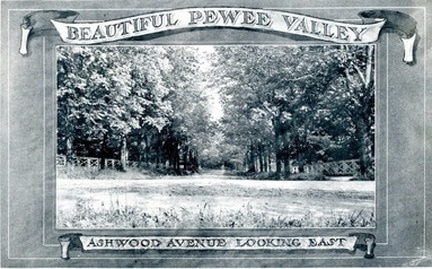 The cover of "Beautiful Pewee Valley"
The cover of "Beautiful Pewee Valley"
Wooldridge probably planned further development along Wooldridge Avenue. The National Register nomination states that a plat, which was referred to in the deed books, mentioned three more lots that evidently never sold.
Other evidence of a serious foray into real estate development is a promotional brochure extolling the town's many virtues. Published by Wooldridge and neighbor George R. Washburne in 1910, "Beautiful Pewee Valley" referred to Pewee Valley as "The Garden Spot of Kentucky" and praised "...Its sloping hills, picturesque nooks and glorious drives..."
Other evidence of a serious foray into real estate development is a promotional brochure extolling the town's many virtues. Published by Wooldridge and neighbor George R. Washburne in 1910, "Beautiful Pewee Valley" referred to Pewee Valley as "The Garden Spot of Kentucky" and praised "...Its sloping hills, picturesque nooks and glorious drives..."
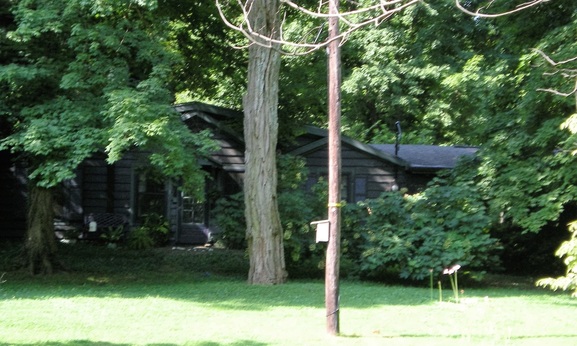
According to the late Pewee Valley Historian Virginia Herdt "Gin" Chaudoin, this unusual home on Wooldridge Avenue was later built from a collection of bath houses scavenged from the Wooldridge estate.
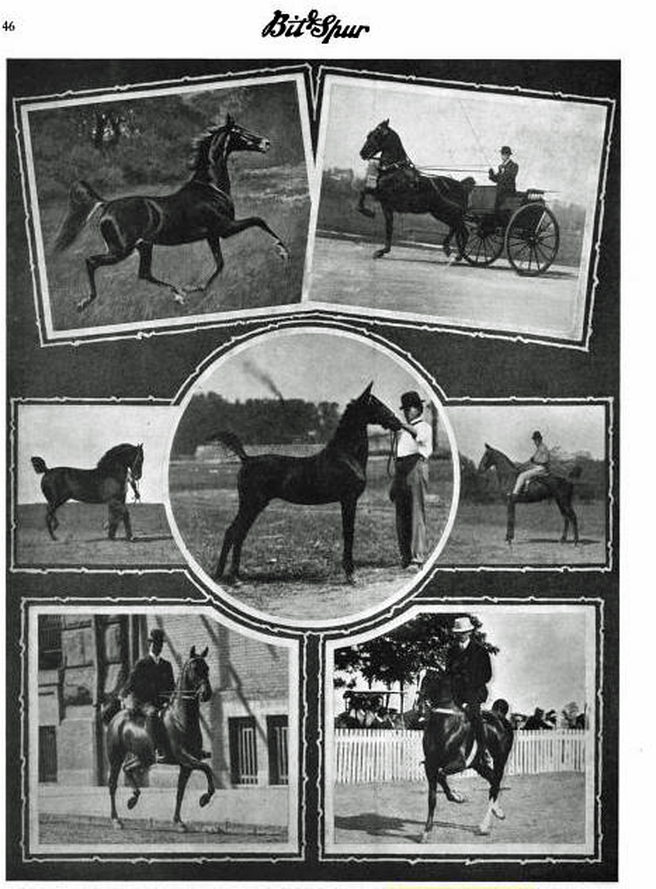 In their Christmas 1908 issue, Bit & Spur magazine ran this photospread of the Powhatan Stock Farm winners. Top left, Queen Quality in her yearling year; Top right, Ben Hur; Middle Left, Princess Louise. Center, Queen of the Ball; Middle Right, American Beauty. Bottom Left, Queen of the May. Bottom Right, Fairy Queen.
In their Christmas 1908 issue, Bit & Spur magazine ran this photospread of the Powhatan Stock Farm winners. Top left, Queen Quality in her yearling year; Top right, Ben Hur; Middle Left, Princess Louise. Center, Queen of the Ball; Middle Right, American Beauty. Bottom Left, Queen of the May. Bottom Right, Fairy Queen.
Wooldridge wasn't just developing the land; he was also developing his Saddlebred business and buying up horses for breeding and show. Some of his purchases attracted press coverage, including his 1906 acquisition of Queen Quality, a seven-month-old filly, which was undefeated in the ring and the "sensation of the State Fair in Louisville"; and Bohemian King, a two-year-old stallion for which he paid the unheard-of sum of $3,000 in 1907.
His efforts paid off. By 1908, his prizewinning horses were gracing the pages of Bit & Spur magazine.
By 1910, he was selling horses at the American Horse Exchange in New York. The March 15, 1910 Courier-Journal reported that, "...The horses consigned by Powhatan Wooldridge of Pewee Valley, Ky., brought $5,845, an average of nearly $600..."
The month after the New York sale, Bit & Spur magazine (Volume 10, Angus Company, April 1910) carried a story about the stock farm's "meteoric rise in show horse history:"
His efforts paid off. By 1908, his prizewinning horses were gracing the pages of Bit & Spur magazine.
By 1910, he was selling horses at the American Horse Exchange in New York. The March 15, 1910 Courier-Journal reported that, "...The horses consigned by Powhatan Wooldridge of Pewee Valley, Ky., brought $5,845, an average of nearly $600..."
The month after the New York sale, Bit & Spur magazine (Volume 10, Angus Company, April 1910) carried a story about the stock farm's "meteoric rise in show horse history:"
|
|
Another of the great breeding establishments is that of the Powhattan (sic) Wooldridge ... known as Powhattan Farm. which is at Pewee Valley, an aristocratic suburb distant about sixteen miles from Louisville on the Louisville & Nashville Railway. Mr. Wooldridge is an amateur that has been very deeply affected with saddle-horseitis, and has the cooperation in his operations of Mr. R. W. Schultze, who brought to his saddle horse efforts several years of practical experience as a trainer of trotting horses. The senior member of this firm is a gentleman of great wealth and has been prominently identified with the horse department of the Kentucky State Fair and the Louisville Horse Show, of which be is one of the directors. This farm has been in operation but a few years, but having the advantage of every facility that can be attained by wealth, brains and experience. as well as the personal oversight of two very practical and enthusiastic horsemen, has made a meteoric rise in show horse history. Probably the most brilliant example of their success is the well known and sensational high-stepper Ben Hur, which was sired by “Reb” Goddard’s famous blue ribbon winner Red Leaf and out of a saddle mare. This horse attained championship honors in the National show after being sold to George Watson of New York. But he is not the only specimen of championship quality that has attended the efforts of Messrs. Wooldridge and Schultze. Under their direction the famous filly Queen Quality continued her successful career, and since her advent they have shown such other sensations as the mare Queen of the May, which they sold to Mr. Lawrence Jones of Louisville and who won with her at the last National show in New York under the name of Diana of the Lea.
|
In their stallion department they have at the head of the stud the truly great saddle-bred horse Glenworth, a son of Highland Denmark, out of a famous saddle mare by Forest Denmark, for many years the premier saddle horse at John T. Woodford's farm at Mt. Sterling. Ky. His second dam was by Roscoe, another famous progenitor of saddle horses; his third dam being by Mambrino La Grand. He is a very apt illustration of the versatility of the saddle horse, for he is the champion heavy harness, high acting horse of this section, defeating every stallion shown against him in Kentucky last year, and also winner of the championship at the Tennessee Tri-State Fair, and of the championship and Overton Cup at the Memphis horse show. He also won the class for the best type of American carriage horse offered by the Bureau of Animal Industry of the Department of Agriculture at both the Kentucky State Fair and at Memphis. As a sire his career seems to be predicted as a foregone success, as the yearling filly, Glen Mary, was invincible last year.
They have also at this farm another saddle-bred horse called Allison King, well enough considered by the authorities so that the United States Government leased him to breed to the saddle mares at the experiment station at Ames, Iowa. The eminent authority, and one of the most widely recognized horsemen in America, Professor Charles F. Curtis, selected this horse as a fit type for the uses of the department. He was sired by Wilson’s King, a son of Harrison Chief, and his dam was a daughter of Barton Wilkes.
The foundation stock at the Pewee Valley Farm now numbers about sixty head counting all ages, sexes and breeds, and is certainly destined to be one of the greatest sources of production of show horses in this state.
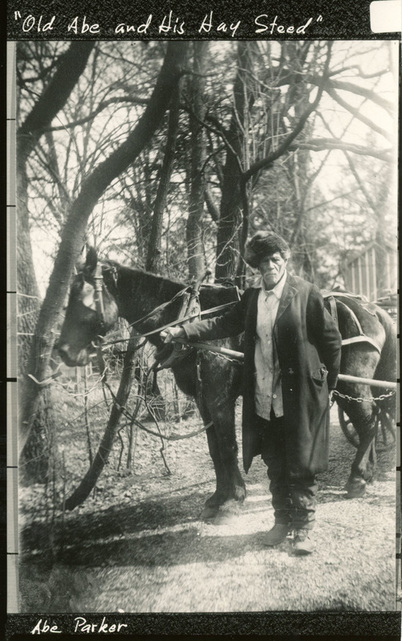 Abe Parker and his horse, by Kate Matthews. From Katie S. Smith's "Pewee Valley: Land of the Little Colonel" published in 1974.
Abe Parker and his horse, by Kate Matthews. From Katie S. Smith's "Pewee Valley: Land of the Little Colonel" published in 1974.
Wooldridge not only hired expert horsemen such as R.W. Schultze and Walter Briggs for his Saddlebred enterprise, he also hired local men, such as Abe Parker, to help out around his stock farm. In a speech about her aunt Kate Matthews given to the Oldham County Historical Society in 1974, Lillian Fletcher Brackett recounted this anecdote about how Powhatan Wooldridge helped Abe Parker get a new horse:
…Abe had a very old mare and an even older carriage that had seen elegant days. I like to think that I remember that it had a bud base in it for a ladies single rose. Abe sat of course in the coachman’s seat in a coonskin cap and drove his ancient mare with a thin little wisp of a colt running by its mother’s side and when he stopped ... it nursed its mother.
The story I remember was that Abe had worked for Mr. Wooldridge long ago. One day Mr. Wooldridge joked with Abe about his old mare lasting so long, and Abe offended said she wasn’t old, just tired and thin. “Well,” said Mr. Wooldridge, “If she is so young, Abe, why don’t you bring her over here and have her bred to my fine stallion and then you’ll have yourself a race horse.” And much to Mr. Wooldridge’s surprise and Abe’s delight that is how Abe got his colt…
…Abe had a very old mare and an even older carriage that had seen elegant days. I like to think that I remember that it had a bud base in it for a ladies single rose. Abe sat of course in the coachman’s seat in a coonskin cap and drove his ancient mare with a thin little wisp of a colt running by its mother’s side and when he stopped ... it nursed its mother.
The story I remember was that Abe had worked for Mr. Wooldridge long ago. One day Mr. Wooldridge joked with Abe about his old mare lasting so long, and Abe offended said she wasn’t old, just tired and thin. “Well,” said Mr. Wooldridge, “If she is so young, Abe, why don’t you bring her over here and have her bred to my fine stallion and then you’ll have yourself a race horse.” And much to Mr. Wooldridge’s surprise and Abe’s delight that is how Abe got his colt…
Powhatan Stock Farm Ads 1907-1913
Wooldridge also joined the American Saddle Horse Breeders Association and within a few years was fighting its founder, Gen. John Breckenridge Castleman, for control of the organization.
Bulletin, Issues 14-19
Kentucky. Dept. of Agriculture, Labor and Statistics
1914
AMERICAN RECORD ASSOCIATIONS AND CLUBS.
HORSES.
Officers American Saddle Horse Breeders Association.
John B. Castleman, Louisville, Ky _ -_President
Claude M. Thomas, Paris, Ky _ First Vice-President
I. H. Thurman, Springfield, Ky _ __Second Vice-President
Powhatan Wooldridge, Pewee Valley, Ky Treasurer
R. H. Lillard, Louisville, Ky _ Secretary
Directors American Saddle Horse Breeders Association.
John B. Castleman _ Louisville, Ky.
Claude M. Thomas _ Paris, Ky.
I. H. Thurman _ Springfield, Ky.
John T. Woodford Mt. Sterling, Ky.
E. W. McCormack _ Waddy, Ky.
John T. Collins North Middletown, Ky.
May Overton _ Nashville, Tenn.
H. A. Greenwell _ Lakenan, Mo.
Jas. Houchin Jefferson City, Mo.
L. L. Wells Cave City. Ky.
J. L. Gay _ Pisgah, Ky.
Powhatan Wooldridge Pewee Valley, Ky.
Gus Ball _ .Versailles, Ky.
A. G. Jones _ North Middletown, Ky.
R. H. Lillard Lawrenceburg, Ky.
Kentucky. Dept. of Agriculture, Labor and Statistics
1914
AMERICAN RECORD ASSOCIATIONS AND CLUBS.
HORSES.
Officers American Saddle Horse Breeders Association.
John B. Castleman, Louisville, Ky _ -_President
Claude M. Thomas, Paris, Ky _ First Vice-President
I. H. Thurman, Springfield, Ky _ __Second Vice-President
Powhatan Wooldridge, Pewee Valley, Ky Treasurer
R. H. Lillard, Louisville, Ky _ Secretary
Directors American Saddle Horse Breeders Association.
John B. Castleman _ Louisville, Ky.
Claude M. Thomas _ Paris, Ky.
I. H. Thurman _ Springfield, Ky.
John T. Woodford Mt. Sterling, Ky.
E. W. McCormack _ Waddy, Ky.
John T. Collins North Middletown, Ky.
May Overton _ Nashville, Tenn.
H. A. Greenwell _ Lakenan, Mo.
Jas. Houchin Jefferson City, Mo.
L. L. Wells Cave City. Ky.
J. L. Gay _ Pisgah, Ky.
Powhatan Wooldridge Pewee Valley, Ky.
Gus Ball _ .Versailles, Ky.
A. G. Jones _ North Middletown, Ky.
R. H. Lillard Lawrenceburg, Ky.
As time wore on, however, Wooldridge was growing disenchanted with his career as a stockman. First, there was his unsuccessful bid for control of the American Saddle Horse Breeders Association in 1909. Four years later, he got into a fight with a horse show judge at the Kentucky State Fair. The September 19, 1913 Courier-Journal told the story:
Mansfield Kirby, 62 years old, widely known as a judge in the horse shows of Kentucky and Tennessee, was arrested while in the arena of the horse show at the state fair last night charged with intent to kill Powhatan Wooldridge, proprietor of the Powhatan Stock Farm, Pewee Valley, in the stable of Press W. Ray of Bowling Green, another horseman.
Mr. Wooldridge ... charges Kirby attacked him with a knife. He will be tried before Magistrate Berry at 9 o'clock this morning ...
At a special meeting of the State Board of Agriculture, called by Commissioner of Agriculture Newman, as soon as he learned of the trouble, it was decided to meet at 10 o'clock this morning, at which time Mr. Kirby, Mr. Wooldridge, Mr. Ray, and Walter Briggs, manager of the Wooldridge horses, will be called upon to show why they should not be expelled from the show, suspended or fined.
Kirby Refuses to Talk
The trouble which led to the arrest of Mr. Kirby is said to have been the result of a statement accredited to Mr. Briggs, in which a decision of Mr. Kirby made in a horse show at a fair at Sanders, last year, was questioned. It reached a climax when Mr. Wooldridge, it is said, announced he would not show his horses at the fair to be held at Knoxville, Tenn., because Mr. Kirby would be in the ring there.
Mr. Kirby's reply to reporters ... when he was asked for a statement was that "He will hold everybody to answer for anything they dare to say about him."
Mr. Briggs declared Mr. Ray ... told him that an official of the Knoxville Fair had repeated a remark to him alleged to have been made by Mr. Briggs, in which a decision in a ring was questioned.
Denies Questioning Decision
"I never questioned any decision made by Mr. Kirby," Mr. Briggs declared, "and I told Ray so. A little later the Knoxville man told Ray in my presence that he had not heard me make any such remark."
"Mr. Ray invited Mr. Briggs and myself to come over ... to have a talk with Mr. Mansfield Kirby," declared Mr. Wooldridge ... "in regard to some matter pertaining to the Knoxville horse show. We went over there and shook hands with Mr. Kirby and everything seemed pleasant. A discussion arose between Mr. Briggs and Mr. Kirby relative to a decision made by Mr. Kirby at Sanders a year ago.
"Mr. Kirby accused Mr. Briggs of having questioned the decision. Mr. Briggs said he had not made any such statement, nor had anyone else. Here I spoke up and said I had heard a Knoxville horse show man, in the presence of Mr. Briggs and Mr. Ray, say that Mr. Briggs had never made such a statement.
Called Him Liar, He Says
"Mr. Kirby then said to me, 'I am not talking to you; keep your mouth out of this discussion.' I replied, 'I am talking to you.' Kirby then said, 'Well you keep your mouth shut. You can't talk while I am talking.' I told him I would talk whenever I thought it was necessary."
Mr. Wooldridge declared other words followed, and that he was then declared a liar by Mr. Kirby. Mr. Wooldridge declared he picked up a glass and threw it at Mr. Kirby, striking him on his head.
"Kirby then drew a knife," Mr. Wooldridge charged, "saying as he did so, 'I will cut your throat.' He made a lunge at me and I shoved him out of the way. Then I grabbed him and Mr. Briggs took the knife out of his hand. I stepped back and as I did stumbled over a tent rope or something and fell down."
Mr. Briggs heard the statement of Mr. Wooldridge to the reporters and when asked what he had to add he declared he could only corroborate the words of his employer.
He declared, however, that he had said he would not show his horses at a fair where Mr. Kirby was a judge, and asserted he had no apologies to make for doing so...
The matter was quickly settled before the State Board of Agriculture, according to this report from the The Saddle and Show Horse Chronicle's September 23, 1913 issue:
The exhibitors and judges in the horse Show ring at the Kentucky State Fair are at peace.
Powhatan Wooldridge, exhibitor of saddle and harness horses, and Mansfield Kirby, widely known judge of the show ring, principals in the encounter Thursday night at the barn of Pres. W. Ray, of Bowling Green, another exhibitor, appeared before the State Board of Agriculture at the Fair grounds yesterday morning and made amends for their conduct. Mr. Ray and Walter Briggs. who were witnesses, also made apologies.
Mr. Wooldridge withdrew the charge of attempt to kill filed against Kirby Friday night. After each of the four men had been heard separately before the board, and had given his version of the trouble, they were called together and handshaking all around took place. They returned to the show ring arm' in arm.
.As a result of the withdrawal of the charge the case against Mr. Kirby was not called before Magistrate Berry yesterday morning.
Commissioner Newman lectured the four horsemen severely for their conduct and warned them of the danger of expulsion, suspension or fine. Mr. Newman said he regretted the occurrence. especially in view of the standing of the principals and the example set to others.
Mansfield Kirby, 62 years old, widely known as a judge in the horse shows of Kentucky and Tennessee, was arrested while in the arena of the horse show at the state fair last night charged with intent to kill Powhatan Wooldridge, proprietor of the Powhatan Stock Farm, Pewee Valley, in the stable of Press W. Ray of Bowling Green, another horseman.
Mr. Wooldridge ... charges Kirby attacked him with a knife. He will be tried before Magistrate Berry at 9 o'clock this morning ...
At a special meeting of the State Board of Agriculture, called by Commissioner of Agriculture Newman, as soon as he learned of the trouble, it was decided to meet at 10 o'clock this morning, at which time Mr. Kirby, Mr. Wooldridge, Mr. Ray, and Walter Briggs, manager of the Wooldridge horses, will be called upon to show why they should not be expelled from the show, suspended or fined.
Kirby Refuses to Talk
The trouble which led to the arrest of Mr. Kirby is said to have been the result of a statement accredited to Mr. Briggs, in which a decision of Mr. Kirby made in a horse show at a fair at Sanders, last year, was questioned. It reached a climax when Mr. Wooldridge, it is said, announced he would not show his horses at the fair to be held at Knoxville, Tenn., because Mr. Kirby would be in the ring there.
Mr. Kirby's reply to reporters ... when he was asked for a statement was that "He will hold everybody to answer for anything they dare to say about him."
Mr. Briggs declared Mr. Ray ... told him that an official of the Knoxville Fair had repeated a remark to him alleged to have been made by Mr. Briggs, in which a decision in a ring was questioned.
Denies Questioning Decision
"I never questioned any decision made by Mr. Kirby," Mr. Briggs declared, "and I told Ray so. A little later the Knoxville man told Ray in my presence that he had not heard me make any such remark."
"Mr. Ray invited Mr. Briggs and myself to come over ... to have a talk with Mr. Mansfield Kirby," declared Mr. Wooldridge ... "in regard to some matter pertaining to the Knoxville horse show. We went over there and shook hands with Mr. Kirby and everything seemed pleasant. A discussion arose between Mr. Briggs and Mr. Kirby relative to a decision made by Mr. Kirby at Sanders a year ago.
"Mr. Kirby accused Mr. Briggs of having questioned the decision. Mr. Briggs said he had not made any such statement, nor had anyone else. Here I spoke up and said I had heard a Knoxville horse show man, in the presence of Mr. Briggs and Mr. Ray, say that Mr. Briggs had never made such a statement.
Called Him Liar, He Says
"Mr. Kirby then said to me, 'I am not talking to you; keep your mouth out of this discussion.' I replied, 'I am talking to you.' Kirby then said, 'Well you keep your mouth shut. You can't talk while I am talking.' I told him I would talk whenever I thought it was necessary."
Mr. Wooldridge declared other words followed, and that he was then declared a liar by Mr. Kirby. Mr. Wooldridge declared he picked up a glass and threw it at Mr. Kirby, striking him on his head.
"Kirby then drew a knife," Mr. Wooldridge charged, "saying as he did so, 'I will cut your throat.' He made a lunge at me and I shoved him out of the way. Then I grabbed him and Mr. Briggs took the knife out of his hand. I stepped back and as I did stumbled over a tent rope or something and fell down."
Mr. Briggs heard the statement of Mr. Wooldridge to the reporters and when asked what he had to add he declared he could only corroborate the words of his employer.
He declared, however, that he had said he would not show his horses at a fair where Mr. Kirby was a judge, and asserted he had no apologies to make for doing so...
The matter was quickly settled before the State Board of Agriculture, according to this report from the The Saddle and Show Horse Chronicle's September 23, 1913 issue:
The exhibitors and judges in the horse Show ring at the Kentucky State Fair are at peace.
Powhatan Wooldridge, exhibitor of saddle and harness horses, and Mansfield Kirby, widely known judge of the show ring, principals in the encounter Thursday night at the barn of Pres. W. Ray, of Bowling Green, another exhibitor, appeared before the State Board of Agriculture at the Fair grounds yesterday morning and made amends for their conduct. Mr. Ray and Walter Briggs. who were witnesses, also made apologies.
Mr. Wooldridge withdrew the charge of attempt to kill filed against Kirby Friday night. After each of the four men had been heard separately before the board, and had given his version of the trouble, they were called together and handshaking all around took place. They returned to the show ring arm' in arm.
.As a result of the withdrawal of the charge the case against Mr. Kirby was not called before Magistrate Berry yesterday morning.
Commissioner Newman lectured the four horsemen severely for their conduct and warned them of the danger of expulsion, suspension or fine. Mr. Newman said he regretted the occurrence. especially in view of the standing of the principals and the example set to others.
Wooldridge was also facing challenges on the home front. In 1911, his parents separated. His mother lived in Louisville with several of his siblings and their families. His father moved to Locust Lodge and joined the Commonwealth Life Insurance Company. The two lived separately the rest of their lives.
In 1915, Margaret and he lost two sons in less than two weeks. Powhatan O. Wooldridge died on October 1 and his obituary appeared in the Courier-Journal the next day:
Powhatan Oboussier (sic) Wooldridge, son of Powhatan Johnston Wooldridge and Margaret Cox Wooldridge, of Pewee Valley, died at the Norton Infirmary yesterday afternoon of tubercular meningitis superinduced by typhoid fever.
The little fellow was one of the most popular in the neighborhood. Although his parents were able to provide him with every necessity and luxury of life, he insisted on making his own way as much as possible, and for eighteen months had carried the Courier-Journal over a route leading out of Pewee. Every morning after covering his route he went to school...
Margaret was pregnant with the couple's fifth child at the time of their oldest son's death. On October 13, James Wooldridge died at birth. Both of them are buried at Cave Hill.
In 1915, Margaret and he lost two sons in less than two weeks. Powhatan O. Wooldridge died on October 1 and his obituary appeared in the Courier-Journal the next day:
Powhatan Oboussier (sic) Wooldridge, son of Powhatan Johnston Wooldridge and Margaret Cox Wooldridge, of Pewee Valley, died at the Norton Infirmary yesterday afternoon of tubercular meningitis superinduced by typhoid fever.
The little fellow was one of the most popular in the neighborhood. Although his parents were able to provide him with every necessity and luxury of life, he insisted on making his own way as much as possible, and for eighteen months had carried the Courier-Journal over a route leading out of Pewee. Every morning after covering his route he went to school...
Margaret was pregnant with the couple's fifth child at the time of their oldest son's death. On October 13, James Wooldridge died at birth. Both of them are buried at Cave Hill.
In 1917 and again in 1918, after his Grand Champion Richelieu King was beaten both years in the $10,000 Stake, Wooldridge wrote The Saddle and Horse Show Chronicle magazine to tell them he was getting out of the business. In 1919, his meteoric rise in the Saddlebred ring came to an abrupt halt when he threw in the towel and sold his entire stock. The Saddle and Horse Show Chronicle's November 19, 1919 issue covered the Powhatan Farm dispersal sale, which attracted breeders from major markets across the U.S.:
RICHELIEU KING CHANGES HANDS
Forty-eight head of saddle horses, principally brood mares and youngsters, were sold for $20,940, or an average of $436.25 a head, at the dispersal sale of Powhatan Farm, Pewee Valley, yesterday. The stud was headed by the famous show stallion, Richelieu King, one of the most noted saddle stallions in Kentucky, and also looming up prominently as a sire, which went to the bid of Lehmann Brothers, well-known merchants of Chicago, at $6,600. The contending bidder was B. R. Pemberton, of Chicago, two other bidders also bidding after the price passed $6,300. One of these was Jack O’Brien of Chicago- who was acting for Jack Dempsey, heavyweight champion boxer of the world. “Dempsey told me to buy him if I liked him," said O'Brien, “and I don't know why I ever stopped, for I certainly do like him." The fourth main contender was Sam Hinkle of Shelbyville, who had a bid for Mr. Beebe, wealthy manufacturer, who wanted him to ride.
Second highest price was paid by the Winchester dealer and exhibitor, W. G. Shropshire, for the three gaited saddle mare, Allaire, the 4-year-old daughter of Richelieu King, who secured her for $2,200. Third highest price was $900 for the yearling filly Anne Bruce by Richelieu King out of Coal Black Lady by Rex Peavine, that went to B. R. Pemberton, of Chicago. Desirable yearlings and weanlings were bid on eagerly, and there was a good demand for brood mares also. Hi Lassie, former show mare and dam of the sensational Lady Beautiful, brought $395 and was not showing heavy with foal. The highest priced brood mare was Golden Gloss, daughter of Highland Denmark, and the grand old mare, Sue Chief, that E. B. Miller, of Salvisa, Ky., paid $415 for. Sue Chief, now 25 years old, looked well and luckily did not fall into the hands of a gypsy, going to F. Hudgens, a breeder of Nashville.
Illinois buyers, and particularly those from Chicago, were very active, securing in addition to Richelieu King a number of the other choicest offerings of the sale. Of the entire list but two horses sold under $100 and both of these were from a mare of untraced pedigree...
Forty-eight head of saddle horses, principally brood mares and youngsters, were sold for $20,940, or an average of $436.25 a head, at the dispersal sale of Powhatan Farm, Pewee Valley, yesterday. The stud was headed by the famous show stallion, Richelieu King, one of the most noted saddle stallions in Kentucky, and also looming up prominently as a sire, which went to the bid of Lehmann Brothers, well-known merchants of Chicago, at $6,600. The contending bidder was B. R. Pemberton, of Chicago, two other bidders also bidding after the price passed $6,300. One of these was Jack O’Brien of Chicago- who was acting for Jack Dempsey, heavyweight champion boxer of the world. “Dempsey told me to buy him if I liked him," said O'Brien, “and I don't know why I ever stopped, for I certainly do like him." The fourth main contender was Sam Hinkle of Shelbyville, who had a bid for Mr. Beebe, wealthy manufacturer, who wanted him to ride.
Second highest price was paid by the Winchester dealer and exhibitor, W. G. Shropshire, for the three gaited saddle mare, Allaire, the 4-year-old daughter of Richelieu King, who secured her for $2,200. Third highest price was $900 for the yearling filly Anne Bruce by Richelieu King out of Coal Black Lady by Rex Peavine, that went to B. R. Pemberton, of Chicago. Desirable yearlings and weanlings were bid on eagerly, and there was a good demand for brood mares also. Hi Lassie, former show mare and dam of the sensational Lady Beautiful, brought $395 and was not showing heavy with foal. The highest priced brood mare was Golden Gloss, daughter of Highland Denmark, and the grand old mare, Sue Chief, that E. B. Miller, of Salvisa, Ky., paid $415 for. Sue Chief, now 25 years old, looked well and luckily did not fall into the hands of a gypsy, going to F. Hudgens, a breeder of Nashville.
Illinois buyers, and particularly those from Chicago, were very active, securing in addition to Richelieu King a number of the other choicest offerings of the sale. Of the entire list but two horses sold under $100 and both of these were from a mare of untraced pedigree...
Powhatan Wooldridge (Senior) Years
Powhatan Johnson Wooldridge died on July 31, 1923, of chronic nephritis. He was only 44. His father appears to have purchased The Locust after his son's death. He continued to live there and work for Commonwealth Life Insurance until his own death -- at the ripe old age of 89 -- on September 14, 1940.
"Edgewood, the story of a family and their house," written by James Wooldridge Powell (Kansas City, Mo., 1978), includes several anecdotes about Powhatan, Sr., known to his family as "Pow":
Powhatan Wooldridge's last will and testament, on file at the Oldham County Court House, underscores the extent of his acrimony toward his wife. Thanks to Oldham County Clerk Julie K. Barr for providing a copy to the Pewee Valley Historical Society:
May 22, 1933
I hereby make this my last Will and Testament
1. To my son C.F. Wooldridge I give my arm in Oldham County, Ky, with all furniture and equipment thereon, encluding silver cups and trophies and request that he maintain same as a summer outing for poor working girls.
2. I have given to him and with his consent hold as Trustee certificate No. 5227 calling for 3500 of the Stock of the Commonwealth Life Insurance Co of Ky.
3. To my daughter Anna May O'Brien I have given certificate No. 5228, calling for 1000 shares of stock of the Commonwealth Life Insurance Co. of Ky, which she has put in my name as trustee.
4. To my daughter Mary Tyler O'Brien I have given certificate No 5229 calling for 1000 shares of stock of the Commonwealth Life Insurance Co of Ky. which with her consent I am holding for her as trustee.
5. I request that my daughters place this stock in the hands of my son C.F. Wooldridge after my death, to hold as trustee for them during their lives.
6. This stock was given to them as their personal, separate estate, free from any claim of courtesy.
7. To my servants Lillie Yocum I give $200
8. To Claude Todd I give $200
9. To Charles Booker I give $100
10. To Emma C. Hardin I give $200
11. In view of the fact that Mrs. Mary C. Wooldridge inherited a large fortune and to who I have already given $29,000.00 I give $1.00.
12. To my grand daughter Mary Lawrence Brown I give $100.00
13. To my grand daughter Chamie Graady I give $100.00
14. To my grand daughter Margaret C. Weidner I give $100.00
15. To my grand son Chas. B. Wooldridge I give $100.00
16. To my grand son Luke C. Wooldridge, I give $100.00
17. The residue of my estate I give to my son C.F. Wooldridge, and I desire him to use as he may see fit in aiding any of my descendants who may be worthy and in need.
18. My son C.F. Wooldridge shall act as Executor of my Will without bond.
P. Wooldridge
I hereby agree to the disposal of my husband P. Wooldridge according to the above will dated May 22 1933 and in consideration of his devising said estate to the beneficiaries stated therein and other considerations hereby acknowledged I relinquish all claims for dower or any other claims against his estate.
Mary C. Wooldridge
Codicil
No beneficiary under this will shall be required to make an accounting of anything I have given during my life. P. Wooldridge
A Codicil dated November 12, 1935
In this codicil to my will of May 22 1933 I direct that the name of Commadore Yocum be substituted for that of Claude Todd and said Commadore Yocum shall receive the two hundred dollars ($200.00) which in section 8 of my I had bequeathed to Claude Todd.
I have given Claude Todd a lot and assisted him to build a house thereon and he shall therefore receive nothing from my estate.
This is my Codicil and shall in no way affect any bequest or beneficiary under my will of May 22 1933 save only said Claude Todd beneficiary in section 7 of this will afore mentioned.
This is a codicil and is in no way to be construed as a will.
P. Wooldridge
I hereby agree to the substitution of Commadore Yocum for Claude Todd and this substitution shall in no way affect my release of my interest in the estate of my husband Powhatan Wooldridge.
Mary C. Wooldridge
Less than a month after her estranged husband's death, on October 14, 1940, Mary Wooldridge appeared before the Oldham County Court to renounce his will. It seems she had lost her inheritance and now very much needed the cash:
Estate of Powhatan Wooldridge, Deceased, Widow's Renunciation of Will.
Comes Mary C. Wooldridge, widow of Powhatan Wooldridge. deceased, who died a resident of and domiciled in Oldham County, Kentucky on the 21st day of September, 1940, and renounces the provisions made for her benefit in the Will of her said deceased husband, Powhatan Wooldridge, which will be offered for probate in the Oldham County Court, Kentucky, on October 21, 1940, and elects instead to take the dowable and distributable share of the estate of her deceased husband, Powhatan Wooldridge, which she, as his widow, is entitled by the statutes of the Commonwealth of Kentucky to have.
The said Mary C. Wooldridge further states that her signature to certain writings appended to the will of her said husband, purporting to be a relinquishment by her of all claims for dower or any other claim against his estate was obtained by duress and by her said husband's threating to discontinue a small allowance which he had been making to her and which she was badly in need of, and that the value of the consideration which she received for executing same was not substantially equivalent to, but, on the contrary, was a mere fraction of the value of the dowable and distributable share of her said husband's then estate which she, as widow, was entitled to by law to receive upon his death in the event she survived him. Wherefore, the fact that she signed said writing does not bar her from now exercising the right to renounce the provisions made for her benefit in the will of her said deceased husband, and to elect to take the dowable and distributable share of his estate which she, as widow, is entitled by the statutes of the Commonwealth to have.
In Testimoney Whereof, she has hereunto subscribed her name at Louisville, Kentucky, this 12th day of October, 1940.
Mary C. Wooldridge
Mary didn't live long after contesting the will. She died just a few months later on December 19, 1940, in Louisville. The two chose to remain separated even in death. Powhatan is buried in Versailles, Ky., while Mary lies in Cave Hill Cemetery in Louisville.
Estate of Powhatan Wooldridge, Deceased, Widow's Renunciation of Will.
Comes Mary C. Wooldridge, widow of Powhatan Wooldridge. deceased, who died a resident of and domiciled in Oldham County, Kentucky on the 21st day of September, 1940, and renounces the provisions made for her benefit in the Will of her said deceased husband, Powhatan Wooldridge, which will be offered for probate in the Oldham County Court, Kentucky, on October 21, 1940, and elects instead to take the dowable and distributable share of the estate of her deceased husband, Powhatan Wooldridge, which she, as his widow, is entitled by the statutes of the Commonwealth of Kentucky to have.
The said Mary C. Wooldridge further states that her signature to certain writings appended to the will of her said husband, purporting to be a relinquishment by her of all claims for dower or any other claim against his estate was obtained by duress and by her said husband's threating to discontinue a small allowance which he had been making to her and which she was badly in need of, and that the value of the consideration which she received for executing same was not substantially equivalent to, but, on the contrary, was a mere fraction of the value of the dowable and distributable share of her said husband's then estate which she, as widow, was entitled to by law to receive upon his death in the event she survived him. Wherefore, the fact that she signed said writing does not bar her from now exercising the right to renounce the provisions made for her benefit in the will of her said deceased husband, and to elect to take the dowable and distributable share of his estate which she, as widow, is entitled by the statutes of the Commonwealth to have.
In Testimoney Whereof, she has hereunto subscribed her name at Louisville, Kentucky, this 12th day of October, 1940.
Mary C. Wooldridge
Mary didn't live long after contesting the will. She died just a few months later on December 19, 1940, in Louisville. The two chose to remain separated even in death. Powhatan is buried in Versailles, Ky., while Mary lies in Cave Hill Cemetery in Louisville.
Photos from the Martin Years Published in "Pewee Valley: The Land of the Little Colonel" by Katie S. Smith, 1974
The Martins: 1941-1973
In 1941, The Locust with 53 acres was sold to Mr. and Mrs. Carl Martin. In her 1974 publication, "Pewee Valley: Land of the Little Colonel," Katie S. Smith described the condition of the property when the Martins purchased it:
...The roof leaked, the yards were overgrown, and the beautiful stonework had been hidden by concrete and stucco. Mrs. Martin, following photos by Kate Matthews, supervised the restoration down to the last details. The furnishings of each room were given equal consideration with careful regard for proportion and elegance; delicate furniture, beds, and washstands upstairs, ornate formality combined with cozy corners in the receiving rooms downstairs. With the death of Mrs. Martin in 1973, The Locust became the site of the area's largest auction...
The 1975 National Register nomination also mentioned the Martins' desire for historical accuracy when they renovated the estate:
The Martins were very interested in the history of the house ... and made extensive changes in an attempt to restore parts of the house to their earlier appearance. They removed several rooms that had been added onto the rear. At some point over the years the stone and brick work of the house had been covered in stucco. The Martins had it removed and the stone and brick mortar was repointed. In the interior of the house they replaced later doors with the originals, which were found in an outbuilding, and removed the enclosed stairway.
Like Mary Johnston at The Beeches, the Martins welcomed Little Colonel fans who came to Pewee Valley to see the homes and settings from Annie Fellows Johnston's popular children's books. In a 1952 Courier-Journal & Times Sunday Magazine article, Adele Brandeis reported:
... Mr. and Mrs. Carl Martin, who bought the Locust in 1941 when it was sadly in need of repair and have brought it, both inside and out, to what it was in The Little Colonel's youth, also have quantities of visitors. Their guest book right up to the present has names of persons from Hawaii, Australia, Hollywood, Boston, Ontario and Texas...
... Mr. and Mrs. Carl Martin, who bought the Locust in 1941 when it was sadly in need of repair and have brought it, both inside and out, to what it was in The Little Colonel's youth, also have quantities of visitors. Their guest book right up to the present has names of persons from Hawaii, Australia, Hollywood, Boston, Ontario and Texas...
Mary's Genealogy Blog provides some insights about Mrs. Martin's failing mental state ca. 1972, the year before she died:
Wilda Martin- Mrs. Martin lived in the oldest home in Pewee Valley and when we met her she was about 80, a widow, and as we realized later, senile. Her home was called, “The Locust” with a driveway so long that you could not see the house from the main road. In the serial “Little Colonel” stories, “The Locust” was the fictional home of the Old Colonel. She liked us and despite our growing realization that she wasn’t playing with a full deck, we visited her several times that summer. Once, while walking with us across the gravel drive she stopped suddenly. She took off her sandal, telling us that she had something fascinating to show us. She turned the sandal over and we could see that because the heal cap had come off; bits of gravel had gotten stuck inside the heel. She marveled as she showed us the printing on the bottom of the shoe that said “Made in Italy” and explained that those were Italian rocks! She wasn’t joking and went on and on about how they had come all the way from Italy. We played along at being thrilled by this and suppressed our giggles. She also showed us her bottle collection, lined up against a mirror in her main hallway. She proceeded to count the bottles, also including their mirror reflections in the count. Mrs. Martin died the next year.
Wilda Martin- Mrs. Martin lived in the oldest home in Pewee Valley and when we met her she was about 80, a widow, and as we realized later, senile. Her home was called, “The Locust” with a driveway so long that you could not see the house from the main road. In the serial “Little Colonel” stories, “The Locust” was the fictional home of the Old Colonel. She liked us and despite our growing realization that she wasn’t playing with a full deck, we visited her several times that summer. Once, while walking with us across the gravel drive she stopped suddenly. She took off her sandal, telling us that she had something fascinating to show us. She turned the sandal over and we could see that because the heal cap had come off; bits of gravel had gotten stuck inside the heel. She marveled as she showed us the printing on the bottom of the shoe that said “Made in Italy” and explained that those were Italian rocks! She wasn’t joking and went on and on about how they had come all the way from Italy. We played along at being thrilled by this and suppressed our giggles. She also showed us her bottle collection, lined up against a mirror in her main hallway. She proceeded to count the bottles, also including their mirror reflections in the count. Mrs. Martin died the next year.
The Locust in 1948, Courtesy of the Late B. Utley Murphy
A short obituary for Wilda Martin ran in the July-August-September 1973 Call of the Pewee:
Mrs. Carl W. (Wilda) Martin died on Sept. 3 at 6:30 p.m. at Pewee Valley Hospital. She was the owner and restorer of the historical home, The Locust, which was the setting of the "Little Colonel" books authored by Annie Fellows Johnston.
Mrs. Martin and her husband, now deceased, bought the house in 1941. They restored and redecorated it in the fashion of the Civil War period.
Mrs. Martin was a member of the Pewee Valley Presbyterian Church and a charter member of the Pewee Valley Woman's Club.
She is survived by two brothers: Judge Harold R. Marquette and George Marquette.
Mrs. Carl W. (Wilda) Martin died on Sept. 3 at 6:30 p.m. at Pewee Valley Hospital. She was the owner and restorer of the historical home, The Locust, which was the setting of the "Little Colonel" books authored by Annie Fellows Johnston.
Mrs. Martin and her husband, now deceased, bought the house in 1941. They restored and redecorated it in the fashion of the Civil War period.
Mrs. Martin was a member of the Pewee Valley Presbyterian Church and a charter member of the Pewee Valley Woman's Club.
She is survived by two brothers: Judge Harold R. Marquette and George Marquette.
The Locust: 1973-Today
After Wilda Martin's death, Citizen's Fidelity Bank handled the estate. They sold it to Oldham County developer Wes Lodsgon, ca. 1974-75. He made many improvements to the property, which has been vacant for several years, including painting it yellow -- the only time in its history the house has been any color other than white -- and adding two bedrooms and a bath to the cottage.
In 1977, he sold it to to John Walser, who served as Mayor of Pewee Valley for some years. The property was one of three historic estates Walser purchased in the 1970s, according to the May 16, 1977 Courier-Journal:
Builder and architectural engineer John A. Walser has been buying up historic homes like crazy. The three he now owns all qualify as genuine WEHT (What Ever Happened To?) material.
The properties are The Locust and Oaklea at Pewee Valley and Spring Station at 3421 Trinity Road in Louisville. All three are for sale and whichever one is left will be the Walser home. He and his wife have six children.
They now live at Oaklea, which was the home of Rob Moore in Annie Fellows Johnston's "Little Colonel" books set in Pewee Valley...
... The Locust, which in 1975 was named to the National Register of Historic Places, and some of its 53 acres are up for sale, but if somebody wants the whole thing "it's real flexible," says Walser. "Whoever buys the house has the say-so on the rest of the property." If there is leftover acreage he might develop it with houses that complement The Locust....
Walser found a buyer for The Locust and today, it's one of the last of Pewee Valley's large estates that remains primarily intact.
The Locust in July, 2015, Photos Courtesy of Linda K. Racque and Donna Russell
Related Links:

